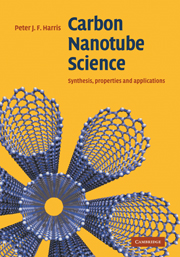Book contents
- Frontmatter
- Contents
- Preface
- 1 Introduction
- 2 Synthesis I: arc- and laser-vaporization, and heat treatment methods
- 3 Synthesis II: catalytic chemical vapour deposition and related methods
- 4 Purification and processing
- 5 Structure
- 6 Physical properties I: electronic
- 7 Physical properties II: mechanical, optical and thermal
- 8 Chemistry and biology of nanotubes
- 9 Carbon nanotube composites
- 10 Filled and heterogeneous nanotubes
- 11 Probes and sensors
- 12 Conclusions
- Name Index
- Subject Index
1 - Introduction
Published online by Cambridge University Press: 20 May 2010
- Frontmatter
- Contents
- Preface
- 1 Introduction
- 2 Synthesis I: arc- and laser-vaporization, and heat treatment methods
- 3 Synthesis II: catalytic chemical vapour deposition and related methods
- 4 Purification and processing
- 5 Structure
- 6 Physical properties I: electronic
- 7 Physical properties II: mechanical, optical and thermal
- 8 Chemistry and biology of nanotubes
- 9 Carbon nanotube composites
- 10 Filled and heterogeneous nanotubes
- 11 Probes and sensors
- 12 Conclusions
- Name Index
- Subject Index
Summary
Carbon in its miscellaneous forms has been used in art and technology since prehistoric times (1.1–1.4). Some of the earliest cave paintings, at Lascaux, Altamira and elsewhere, were produced using a mixture of charcoal and soot. Charcoal, graphite and carbon black (a pure form of soot) have been used as drawing, writing and printing materials ever since: photocopier toner is largely composed of carbon black. Coal and charcoal, of course, have been used as fuels for millennia, and charcoal played an important role in what might be considered humankind's first technology, the smelting and working of metals. Charcoal was used in this way right up to the eighteenth century, when it began to be replaced by coke, a development which helped to stimulate the Industrial Revolution. With the development of the electrical industry in the late nineteenth century, a demand developed for graphite. The American Edward Acheson is credited with producing the first synthetic graphite in 1896. In the twentieth century, the importance of activated carbon in purifying air and water supplies grew steadily, and the invention of carbon fibres in the 1950s provided engineers with a new lightweight, ultra-strong material. Diamonds, like graphite, have been known since antiquity, but until quite recently were only used decoratively. The development of a commercial synthetic method at General Electric in the 1950s opened the way for the industrial use of diamonds.
The history of carbon science is littered with illustrious names. Antoine Lavoisier, in a famous experiment in 1772, proved that diamonds are a form of carbon by demonstrating that they produce nothing but carbon dioxide on combustion.
- Type
- Chapter
- Information
- Carbon Nanotube ScienceSynthesis, Properties and Applications, pp. 1 - 13Publisher: Cambridge University PressPrint publication year: 2009
- 2
- Cited by

